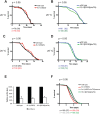The Caenorhabditis elegans Protein FIC-1 Is an AMPylase That Covalently Modifies Heat-Shock 70 Family Proteins, Translation Elongation Factors and Histones
- PMID: 27138431
- PMCID: PMC4854385
- DOI: 10.1371/journal.pgen.1006023
The Caenorhabditis elegans Protein FIC-1 Is an AMPylase That Covalently Modifies Heat-Shock 70 Family Proteins, Translation Elongation Factors and Histones
Abstract
Protein AMPylation by Fic domain-containing proteins (Fic proteins) is an ancient and conserved post-translational modification of mostly unexplored significance. Here we characterize the Caenorhabditis elegans Fic protein FIC-1 in vitro and in vivo. FIC-1 is an AMPylase that localizes to the nuclear surface and modifies core histones H2 and H3 as well as heat shock protein 70 family members and translation elongation factors. The three-dimensional structure of FIC-1 is similar to that of its human ortholog, HYPE, with 38% sequence identity. We identify a link between FIC-1-mediated AMPylation and susceptibility to the pathogen Pseudomonas aeruginosa, establishing a connection between AMPylation and innate immunity in C. elegans.
Conflict of interest statement
The authors have declared that no competing interests exist.
Figures








Similar articles
-
Unrestrained AMPylation targets cytosolic chaperones and activates the heat shock response.Proc Natl Acad Sci U S A. 2017 Jan 10;114(2):E152-E160. doi: 10.1073/pnas.1619234114. Epub 2016 Dec 28. Proc Natl Acad Sci U S A. 2017. PMID: 28031489 Free PMC article.
-
Chaperone AMPylation modulates aggregation and toxicity of neurodegenerative disease-associated polypeptides.Proc Natl Acad Sci U S A. 2018 May 29;115(22):E5008-E5017. doi: 10.1073/pnas.1801989115. Epub 2018 May 14. Proc Natl Acad Sci U S A. 2018. PMID: 29760078 Free PMC article.
-
Translation initiation or elongation inhibition triggers contrasting effects on Caenorhabditis elegans survival during pathogen infection.mBio. 2024 Nov 13;15(11):e0248524. doi: 10.1128/mbio.02485-24. Epub 2024 Sep 30. mBio. 2024. PMID: 39347574 Free PMC article.
-
FIC proteins: from bacteria to humans and back again.Pathog Dis. 2018 Mar 1;76(2). doi: 10.1093/femspd/fty012. Pathog Dis. 2018. PMID: 29617857 Review.
-
Local and long-range activation of innate immunity by infection and damage in C. elegans.Curr Opin Immunol. 2016 Feb;38:1-7. doi: 10.1016/j.coi.2015.09.005. Epub 2015 Oct 28. Curr Opin Immunol. 2016. PMID: 26517153 Review.
Cited by
-
FicD sensitizes cellular response to glucose fluctuations in mouse embryonic fibroblasts.Proc Natl Acad Sci U S A. 2024 Sep 17;121(38):e2400781121. doi: 10.1073/pnas.2400781121. Epub 2024 Sep 11. Proc Natl Acad Sci U S A. 2024. PMID: 39259589 Free PMC article.
-
Alpha-Synuclein Is a Target of Fic-Mediated Adenylylation/AMPylation: Possible Implications for Parkinson's Disease.J Mol Biol. 2019 May 31;431(12):2266-2282. doi: 10.1016/j.jmb.2019.04.026. Epub 2019 Apr 27. J Mol Biol. 2019. PMID: 31034889 Free PMC article.
-
Monoclonal Anti-AMP Antibodies Are Sensitive and Valuable Tools for Detecting Patterns of AMPylation.iScience. 2020 Nov 13;23(12):101800. doi: 10.1016/j.isci.2020.101800. eCollection 2020 Dec 18. iScience. 2020. PMID: 33299971 Free PMC article.
-
Small-Molecule FICD Inhibitors Suppress Endogenous and Pathologic FICD-Mediated Protein AMPylation.ACS Chem Biol. 2025 Apr 18;20(4):880-895. doi: 10.1021/acschembio.4c00847. Epub 2025 Mar 4. ACS Chem Biol. 2025. PMID: 40036289 Free PMC article.
-
In vitro AMPylation Assays Using Purified, Recombinant Proteins.Bio Protoc. 2017 Jul 20;7(14):e2416. doi: 10.21769/BioProtoc.2416. Bio Protoc. 2017. PMID: 29170749 Free PMC article.
References
MeSH terms
Substances
Grants and funding
LinkOut - more resources
Full Text Sources
Other Literature Sources
Molecular Biology Databases
Research Materials

